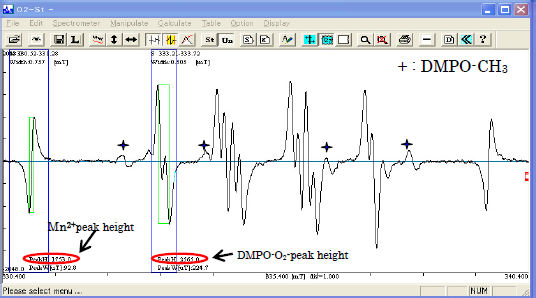Evaluation of Active Oxygen Scavenging Activity 1 O2・-
ER070002E
It is well known that some active oxygen species can cause oxidation reactions that are problematic in biological systems, e.g. become a trigger for various diseases. Therefore, evaluation of active oxygen scavenging (antioxidation) activity is commonplace in fields such as drugs, food, supplement development, etc.
Here, we introduce a method to evaluate the scavenging activity of the superoxide anion radical ( O2・-) which is a common active oxygen species found in living bodies.
- Reagent
DMPO 5,5-dimethyl-1-pyrroline-N-oxide (spin trap agent)Reagent Maker Concentration Sampling Vol./Assay 1.DMPO Labotec Stock Solution 15μl 2.Hyx Sigma -Aldrich 5 mM-H2O 50μl 3.Buffer/DMSO(1/5dil) - 0.1 mol/l 35μl 4.Standard (SOD)/sample a series of concentrations 50μl 5.XOD Roche 0.4 U/ml-buffer 50μl Total 200μl
Hyx hypoxanthine,
Buffer : 0.1 mole/l Phosphate buffer (pH 7.8)
DMSO to be added to reduce the influence of DMPO-OH co-existing on the spectrum.
SOD superoxide dismutase
XOD xanthine oxidase - Measurement Procedure:
1. Make each of the above reagents in labelled tubes.
2. Add reagents 1 to 4 and mix thoroughly for 1 to 2 seconds in a test tube, then add 5 and mix thoroughly for about 5 seconds.
3. Place the solution into an aqueous cell and cap it, wipe the exterior, then insert it into the cavity.
4. Start ESR measurement after a known time (e.g. 1 minute) after the addition of XOD to the solution.
5. Measure the height of Mn2+ peak and DMPO-O2-peak from the spectrum, and calculate the relative intensity (R=DMPO-O2-/Mn2+) as shown in Fig.1.

Fig.1 DMPO-O2- spectrum (when DMSO is added). - ESR Measurement Conditions:
Field: 335±5 mT;
Power: 4 to 8 mW;
Modulation Width: 0.079 mT;
Sweep Time: 2 to 4 min;
Time Const.: 0.1 to 0.3 sec; Amplitude: 250 to 400 - DMPO-O2- Spectrum Analysis
Fig. 2 shows the DMPO-O2- spectrum. Here, the unpaired electrons are localized on the N-O orbital and the signal is split into 12 lines due to hyperfine interaction with N, H-atom (β), and H-atom (γ). The weak signals observed on both sides of these signals are derived from co-existing DMPO-OH. In order to reduce the quantity of DMPO-OH, DMSO should be added.
In this case, DMPO-CH3 (marked “+” in Fig.1, composed of 6 lines, 2 of which overlap with DMPO-O2- signals and are obscured) generated from the reaction of DMSO with HO・is observed.

Fig.2 ESR spectrum of DMPO-O2- - Anti-oxidation Capability Evaluation
When a sample with anti-oxidation activity is added to the reagent mixture series as above, DMPO-O2- signal will reduce according to the level of anti-oxidation activity. When the anti-oxidation activity of the sample is to be measured, create a calibration curve with a series of SOD concentrations. As SOD is a substance known to have a very strong anti-oxidant activity against O2・-, it is a good standard substance. Next, add the unknown sample solution to the solution in the same way and obtain R for each case, and then the anti-oxidation activity, as SOD-equivalent concentration, is obtained from the calibration curve. (Refer to ER040001 & ER040004). - Reagent Handling Precautions
DMPO is not so stable and is decomposed by heat, ultraviolet, or oxygen to give background signals. As the melting point is 35°C only the amount required should be melted and the remainder refrozen. If the reagent bottle is then filled with nitrogen gas, it may be preserved for a relatively long time.
As hyx is only sparingly soluble, it should be dissolved in water at 50°C. Preservation for about a month is possible if refrigerated.
SOD is dissolved in phosphate-buffer.
XOD, as the rot difference of O2・- generation activity is not negligible. As it is an unstable enzyme, it needs to be used within a month once opened.
An example of SOD dilution series: 30, 15, 7.5, 3.75, 1.88, 0.94, 0 unit/ml.
SEARCH APPLICATIONS
Related Products
Are you a medical professional or personnel engaged in medical care?
No
Please be reminded that these pages are not intended to provide the general public with information about the products.
